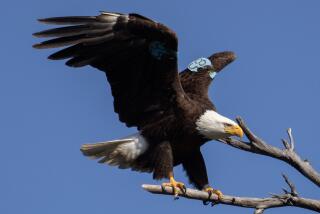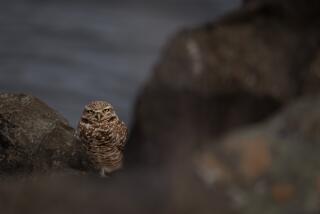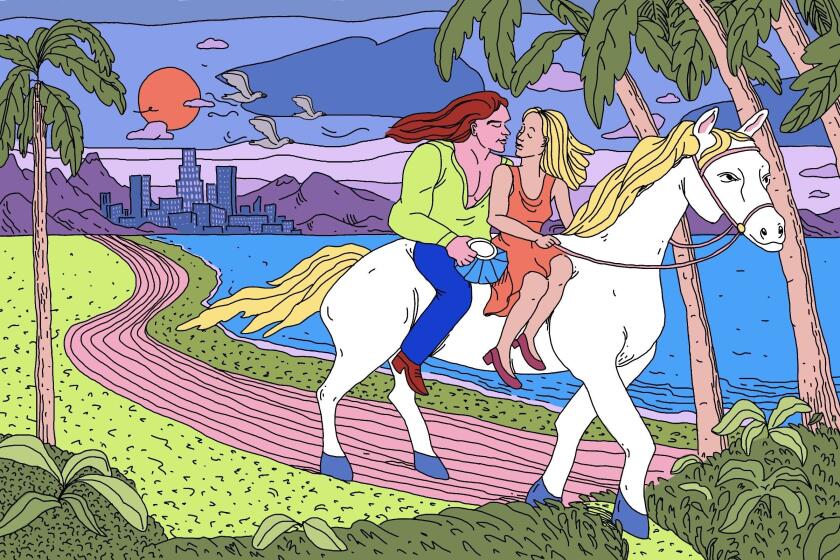Nest efforts in a large-scale iguana project produce a baby boom
A baby boom is underway at the San Diego Zoo among the Grand Cayman blue iguanas, one of the world’s most endangered lizards.
Since 2007, the zoo has been part of an international effort to save the blue iguana. Despite elaborate efforts at providing the right environment, results have been modest: three or four hatchlings a year.
But in the past week, nine blue iguana hatchlings were reported at the zoo’s Anne and Kenneth Griffin Reptile Conservation Center.
Jeff Lemm, the zoo’s research coordinator for lizards, credits the changes that he made for the younger of the center’s two breeding females. She had never had a live hatchling.
“I tweaked the nest situation,” Lemm said Thursday. “She fell for it.”
As this spring’s breeding season had approached, Lemm was not worried about the male stud-lizards, Big Daddy and Bluey.
But Lemm was unsure about a young unnamed female selected as Bluey’s mate.
To provide her with motivation to lay eggs after she and Bluey got together, Lemm found a hollowed-out tree stump, filled it with soft, warm dirt and bathed it in warm light.
The female burrowed in and laid a clutch of eggs. Tension mounted as Lemm and others waited weeks for the results.
“I saw the eggs and said, ‘Please be fertile,’” Lemm said. “And when we got the hatchlings, it was beautiful. We were all very excited.”
Two of the eggs were fertile, and in the past week, out came two hatchlings.
Added to the seven from an older, more reliable female — Big Daddy’s mate — it gave the zoo more hatchlings than in any previous year.
Many of the Caribbean’s lizard species are endangered but none so much as the blue iguana on Grand Cayman, a British territory south of Cuba. Reptile specialists at one point named it the world’s most endangered iguana.
In the wild, blue iguanas can take on a dragonlike mien at 5 feet long and up to 30 pounds. But they are vulnerable to cars, snakes and other predators, livestock and an occasional hurricane.
“The blue iguana was taking a beating in the wild,” Lemm said.
By 2002, the population had dwindled to a few dozen. So the Blue Iguana Recovery Program on the island teamed up with American zoos in a rescue effort.
The San Diego Zoo was a natural after its success in studying and captive-breeding the rock iguanas that inhabit the shoreline of the U.S. Navy base at Guantanamo Bay, Cuba.
The blue iguana is not yet out of danger — cats and dogs continue to devour its eggs on Grand Cayman, and hurricanes are often lurking — but there are encouraging signs.
More than 500 blue iguanas — captive-bred — have been released into the wild, zoo officials said.
Blue iguanas hatched at the San Diego Zoo have been sent to zoos throughout the United States to produce more of the species. Two will be shipped soon to Disney’s Animal Kingdom in Orlando, Fla.
The two breeding females and their mates will remain in San Diego, an insurance policy in case the Grand Cayman population nose-dives despite measures taken by the government there to protect the iguana, including a 200-acre sanctuary zone.
The San Diego Zoo’s blue iguanas are not considered big enough or stable enough to be on public exhibit. Neither the females nor their mates have reached their full size.
Lemm thinks next year’s breeding season for the blue iguanas will be even better, as the younger female gets bigger, older and more accustomed to the ritual of mating and reproduction.
“Next year, I expect her to lay even more good eggs,” Lemm said, “but you never know with reptiles.”
More to Read
Sign up for our L.A. Times Plants newsletter
At the start of each month, get a roundup of upcoming plant-related activities and events in Southern California, along with links to tips and articles you may have missed.
You may occasionally receive promotional content from the Los Angeles Times.






